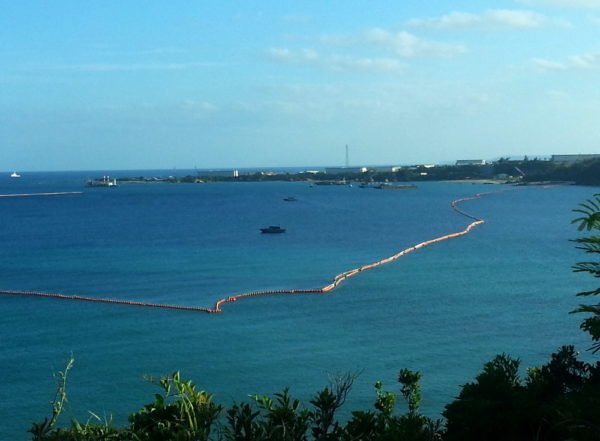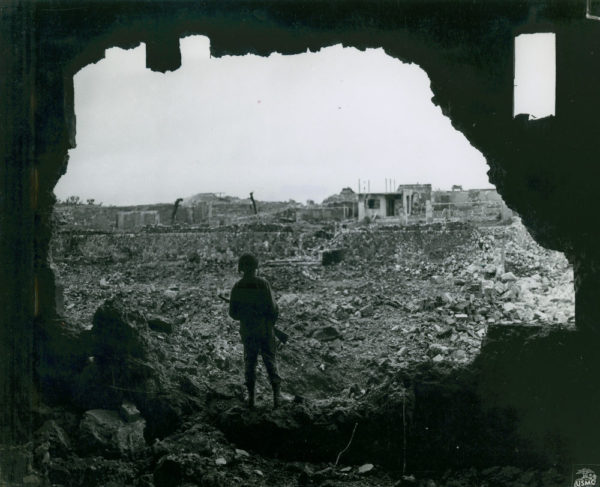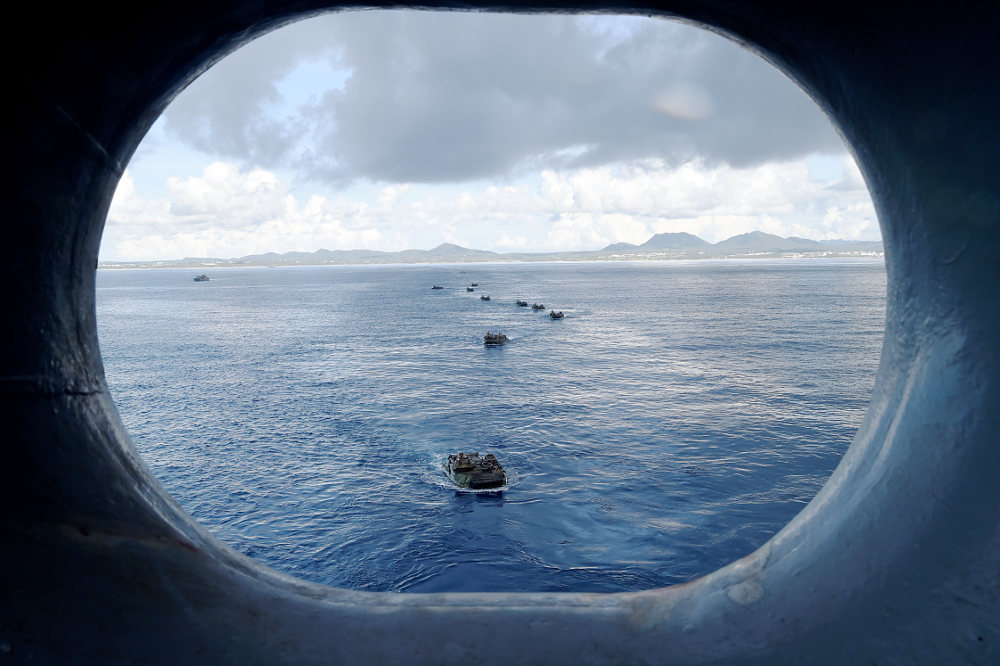More than six decades after America’s post-World War II occupation of Japan officially ended, more than 50,000 US troops remain there. Over half of them are stationed on the southern Japanese island of Okinawa, an island with a population of 1.3 million, which the United States values as a strategic base close to China and North Korea.
Although few people outside of Japan know about it, demonstrations go on daily against the thirty-two US military bases and forty-eight training sites on Okinawa, which occupy about a fifth of the island’s land. The protests have been a feature of Okinawan life since the beginning of the US occupation in 1945 (which officially ended for most of the country in 1952, but not for Okinawa until two decades later). From time to time the discontent has exploded into massive street demonstrations, often in response to violent crimes connected to military personnel, such as the 1995 rape of a twelve-year-old girl by three American soldiers and the 2016 rape and murder of a twenty-year-old woman by a former marine working as a contractor for the US military.
In the late 1990s, the US military and Japanese government announced plans to build a new helipad in the far north of Okinawa and relocate the aging Futenma air base to the Henoko district of Nago, a city near the island’s center. For a time, fierce public opposition stymied those plans, but after the conservative government of Japanese prime minister Shinzo Abe took power in 2012, the work moved ahead. The plans for Henoko involve the expansion of the Marine Corps base already there, Camp Schwab, and the construction of a military runway in the waters of Oura Bay, which critics say will destroy coral reef and seagrass essential to the survival of aquatic life like dugongs, a manatee-like species of marine mammal.
In 2017, a poll by the Japanese newspaper Asahi Shimbun found that about two-thirds of Okinawans surveyed were opposed to the Henoko project. Local activists believe it amounts to an overall expansion of US bases on Okinawa, which they claim the government is trying to pass off as just a relocation of existing forces. In Oura Bay, they have formed a “canoe team” to monitor the construction from the water. Mobilizing dozens of boats at a time, the activists have also conducted “sit-ins-on-the-sea” to block the work, which so far has included the building of a barrier in the sea, preparatory boring ahead of the construction of the runway, and the dumping of sand to fill in portions of the bay.
The Abe administration not only supports the planned construction, but has even agreed to finance it. Japan has remained militarily dependent on the United States ever since the postwar occupation, when it was forced to accept a new constitution banning it from building offensive forces, and it has long supported the establishment of US military bases throughout the region. At the same time, Japanese nationalists have pushed—with US backing—to remilitarize the country. In recent years, lawmakers have approved legislation reinterpreting the constitution to allow Japanese troops to fight overseas in support of allies. The country’s “self-defense” forces have operated in far-flung war zones like Iraq and South Sudan, and Japan now boasts the eighth-largest military budget in the world, according to the Stockholm International Peace Research Institute. A key goal of the government now in power is to rewrite the constitution in order to loosen the remaining restrictions on Japan’s armed forces. Regardless of whether that happens, though, the US and Japan will likely continue their close military alliance, which experts say is one of America’s strongest strategic partnerships.
Hiroshi Inaba, a sixty-seven-year-old Japanese peace activist, received an eight-month suspended prison sentence last year because of his work protesting the US military presence on Okinawa. Originally from mainland Japan, he moved to Okinawa in 2014, just after protesters began engaging in regular sit-ins at Camp Schwab. In 2016, he was charged with “forcibly obstructing official business” after he and other protesters piled concrete blocks outside the base’s gates to prevent construction vehicles from entering. He is currently appealing the guilty verdict.
We interviewed Inaba last year about how the anti-base movement inspired him to relocate to Okinawa, the successful hunger strike he carried out to object to the conditions of his imprisonment, and the importance of international pressure in rolling back the US military presence in Japan.

Why did you move to Okinawa?
I originally came here on a sightseeing trip, but after I saw the demonstrations [at Camp Schwab]—the old people being dragged away by the riot police—I thought that I had to do something. I decided to move to Okinawa.
More than 70 percent of US bases in Japan are in Okinawa. Okinawan people don’t want the US base construction, but they’re not being listened to. People here deserve democracy and human rights. I don’t know what the results of our protests will be, but we have to do it.
Can you tell us about the resistance to the base construction in Henoko?
They started [exploratory] boring under the sea in Oura Bay in 2004, but activists managed to stop them. Protesters climbed their scaffolding and slept there all night in 2005. Eventually the government gave up. They couldn’t finish the boring.
Almost ten years passed, and prime ministers changed. In 2012, [Shinzo] Abe’s right-wing government came to power. They restarted the construction at Henoko. They had to bore at fourteen points in Oura Bay. People resisted again, but this time, unsuccessfully. Unfortunately, I think most of the boring is now finished.
The next phase of construction has started: building a runway in the bay. They are bringing big loads full of sand and rock [to fill in the sea].
Some people protest because they’re upset about nature being destroyed—others because of the noise pollution at night from the Osprey military helicopter flights, or because of the lack of democracy, or because [their] relatives were raped by US soldiers.
How does the history of Okinawa relate to the opposition to US bases here?
Okinawa is disconnected from the rest of Japan. People here are treated differently and discriminated against. This has been the case since the end of World War II.
A quarter of the people on Okinawa died in the Second World War. Okinawa was the only place in Japan where US and Japanese soldiers fought on the land. There were so many Okinawan civilian victims. The Japanese army even forced people to commit mass suicide so that they wouldn’t be captured by the US troops. People who were children at that time are now in their eighties. They don’t want to see a repeat of that time—that’s why they oppose the military.

After the war, the US government thought that Okinawa could be a keystone in their policy against China. US occupation on the island lasted for twenty-seven years, and people used the dollar note. Okinawa wasn’t returned to Japan until 1972.
Do people in mainland Japan understand what’s happening in Okinawa?
Now, after the protests, more people on the mainland know about Okinawa, but they’re not interested. Maybe they think that they can’t do anything because it’s a US base—that they can’t reject it. Most Japanese people think that way.
Can you tell us about your arrest?
January 2016 was an unusual time in the movement. Riot police had been sent to Okinawa from different prefectures, and people were being arrested or injured at the protests all the time. Every day, big trucks were bringing construction materials into Camp Schwab. People were very angry.
At that time I brought fifty to a hundred concrete blocks to the sit-in. A few people put the blocks in front of the gate, and others followed. The police had to carry them away.
After that, I hired two cars, and we decided to buy lots of concrete blocks. Every day we blocked the gate with a hundred or two hundred blocks—in one week, maybe 1,400. We repeated it every day, two or three times. The action was successful in delaying the base construction.
The police had been watching and videotaping me. One morning, six police came to my apartment. They charged me with “interfering with business.” They searched my room and seized my things. Ten months later they returned and took me to the police station in Nago, where they kept me in a cage for one month. They interrogated me almost every day, twice a day for one hour. When they brought me for interrogation, I was in handcuffs with my arm locked to a chair. I was alone when questioned, without a lawyer. During the interrogation I would chat and make jokes, but try my best to ignore their questions. Sometimes I enjoyed the interrogation because the rest of the time I had no one to speak to.
Why do you think you were arrested?
They target people who influence people, or who make good speeches. The police secretly prepare the arrests with the Japanese government. Another influential activist, [Hiroji] Yamashiro, was arrested at the same time for cutting the wire fence around a US base. They put him in prison for 150 days.
Can you tell us about your hunger strike?
I started a hunger strike on my second day in the police station. During the strike I only took liquid, and sometimes prunes. I lost fourteen kilograms [thirty pounds]. People were very worried about me, and they said I should stop—otherwise, it would affect my health.
The hunger strike was the only thing I could do to improve my situation in the police station. That’s why I started. The newspapers reported it, and I was able to speak to journalists.
After one month, I was moved from the police station to Naha prison [in the south of the island]. This was a long time, as normally people only stay at the police station for three weeks, maximum. When I got to the prison, I stopped my hunger strike.
I was released from prison on the condition that I not make contact with Mr. Yamashiro and [Atsuhiro] Soeda [another activist who had been arrested]. Our group had to pay big money—three million yen [about $28,000, as bail]—for my release. The price was much higher for Mr. Yamashiro, and altogether it cost ten million yen [about $94,000] for the two of us. Because of that, my lawyer advised me not to go to the protests [while the case was ongoing]. If we were arrested again, it would be too costly.
What can people do in solidarity with the struggle in Okinawa?
Tell people what’s happening in Okinawa—that’s the thing I want people to do the most. A lot of people here can’t speak English, so they can’t tell the outside world what’s going on. If foreign countries criticize Abe and the Japanese government, this could have an effect.
It’s useful for people to come from Europe to join the protests. I was here for three years, and I noticed a big difference. There weren’t so many international people here three years ago—no foreign people or foreign journalists. Now, many people and journalists are coming, and people have demonstrated outside embassies in London and Washington. This really helps our struggle.
Eliza Egret and Tom Anderson are part of Shoal Collective, a newly formed cooperative of writers and researchers writing for social justice and a world beyond capitalism. Twitter: @shoalcollective
- Follow us on Twitter: @inthefray
- Comment on stories or like us on Facebook
- Subscribe to our free email newsletter
- Send us your writing, photography, or artwork
- Republish our Creative Commons-licensed content

